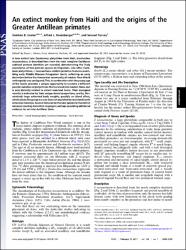/admin/item?itemID=6e8c92a0-4b60-4ece-aa74-74a99892e1e3
An extinct monkey from Haiti and the origins of the Greater Antillean primates

Ver/
Tipo de acceso
AbiertoTipo de Material
ArtículoTipo de Contenido
Investigación científicaIdioma
InglésAudiencia
Técnicos, profesionales y científicosColección
- Investigación ambiental [1725]
Metadatos
Mostrar el registro completo del ítem| Sinopsis: | A new extinct Late Quaternary platyrrhine from Haiti, Insulacebus toussaintiana, is described here from the most complete Caribbean subfossil primate dentition yet recorded, demonstrating the likely coexistence of two primate species on Hispaniola. Like other Caribbean platyrrhines, I. toussaintiana exhibits primitive features resembling early Middle Miocene Patagonian fossils, reflecting an early derivation before the Amazonian community of modern New World anthropoids was configured. This, in combination with the young age of the fossils, provides a unique opportunity to examine a different parallel radiation of platyrrhines that survived into modern times, but is only distantly related to extant mainland forms. Their ecological novelty is indicated by their unique dental proportions, and by their relatively large estimated body weights, possibly an island effect, which places the group in a size class not exploited by mainland South American monkeys. Several features tie the new species to the extinct Jamaican monkey Xenothrix mcgregori, perhaps providing additional evidence for an inter-Antillean clade. |
| Autor(es): | Cooke, Siobhán B.
Rosenberger, Alfred L. Turvey, Samuel |
| Año: | 2011 |
| Publicado: | Proceedings of the National Academy of Sciences, 108(7), 2699-2704 |
| Citación: | Cooke, S. B., Rosenberger, A. L., & Turvey, S. (2011). An extinct monkey from Haiti and the origins of the Greater Antillean primates. Proceedings of the National Academy of Sciences, 108(7), 2699-2704. Recuperado de: |
| URI: | https://bvearmb.do/handle/123456789/5072
|

